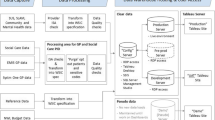Abstract
An electronic patient database linking prescribes with a Dutch community pharmacy consortium was evaluated in a subset of the population of Noordwijk (11,760 patients out of a total of 25,600). The pharmacy database (a file of 41 disease contra‐indications representing a subset of the prescribers' medical diagnosis) was studied in order to assess its value for the accurate discrimination of target patient groups within the community and for support to the pharmaceutical care of individual patients. The aim was to examine the application of the pharmacy records to pharmaceutical care, tested by measuring the accuracy of the pharmacy database to predict the community public health profile; and, more specifically, the accuracy to identify three potential target groups for pharmaceutical care. The records of patients with angina, chronic respiratory disease and diabetes (n=1116), representing 65% of the total pharmacy morbidity records, were studied in detail and verified by the files and texts of the prescriber's individual patient records. From samples of patients (n=273) from the three patient groups, the extent and nature of co‐morbidity, polypharmacy (drug entities prescribed annually) and drug therapy instability (prescription changes to dose or dose form annually) were characterised. Angina patients showed the most co‐morbidity, 46% having three or more additional diseases; chronic respiratory disease patients showed most drug therapy instability; and insulin‐dependent diabetic patients received most polypharmacy per disease. The pharmacy database predicted the prevalence of 10 of 23 relevant disease categories (representing 51% of the total morbidity on the medical records). However, the prevalences of eight categories were underestimated and of five categories overestimated. Of the three patient groups, 73% of patients appeared on both the pharmacy and the medical database. Of the total co‐morbidity recorded for these patients, 68% of records were common to both databases. The database discrepancies (32%) were due to morbidity omitted (12%) and morbidity unverified (10%) on the pharmacy database, together with morbidity omitted from the medical database (10%). The current pharmacy database provides a limited view of morbidity. A strategic approach to pharmaceutical care requires pharmacists and prescribers to verify and share patient information if patient groups and individuals within a group are to be usefully targeted.
Similar content being viewed by others
References
Statement on Pharmaceutical Care. UK Clinical Pharmacy Association. Pharmaceutical Journal 1996;256:345‐6.
Koechler J. Indicators for the selection of ambulatory patients who warrant pharmacist monitoring. American Journal of Hospital Pharmacy 1989;46:729‐31.
Deady JE and Lepinski PW. Measuring the ability of clinical pharmacists to effect drug therapy changes in a family practice clinic using prognostic indicators. Hospital Pharmacy 1991;26:93‐7.
Rogers PJ and Rees JE. Comparison of the use of patient medication records in community pharmacy between 1991 and 1995: (1) The utilisation of patient medication records and recording of product details. Pharmaceutical Journal 1996;256:161‐6.
Rogers PJ and Rees JE. Comparison of the use of patient medication records in community pharmacy between 1991 and 1995: (2) The recording of patient' details. Pharmaceutical Journal 1996;256:491‐5.
Hannaoui A, Krass IK, Benrimoj SI. Review of computerised patient medication records to determine potential clinical interventions in community pharmacy. International Journal of Pharmacy Practice. 1996;4:162‐7.
Rogers PJ, Rees JE. General medical practitioners' attitudes towards the use of patient medication records. International Journal of Pharmacy Practice. 1995;3:163‐8.
Leufkens H and Urquhart PW. Automated record linkage and other approaches to pharmaco‐epidemiology in The Netherlands. In: Strom B (ed). Pharmaco‐epidemiology. 2nd ed 1994.
Heerdink E, Leufkens H, Koppedraijer C, Bakker A. Information on drug use in the elderly: A comparison of pharmacy, GP and patient data. Pharmacy World and Science 1995;17:20‐4.
Lamberts LH, Wood M (eds). International Classification of Primary Care. Oxford Medical Press 1987.
Lamberts H, Wood M, Hofmann‐Okker I. The International Classification of Primary Care in the European Community. Oxford Medical Press 1993.
Voelby R. Population based medicine merges clinical care and epidemiological techniques. Journal of the American Medical Association 1994;271:1301‐12.
Shanks J, Kheraj S, Fish S. Better ways of assessing health needs in primary care. British Medical Journal 1995;310:480‐1.
Charlton B, Calvert N, White M, Rye G. Health promotion priorities for general practice: constructing and using indicative prevalences. British Medical Journal 1994;308:1019‐21.
Gilliland A, Mills K, Steele K. General practitioner records on computer–'handle with care'. Family Practice 1992;9:441‐50.
Knottnerus JA, Metsemakers J, Hoppencer P, Limon C. Chronic illness in the community and the concept of social prevalence. Family Practice 1992;9:15‐20.
Schellevis F, Velden J, Lisdonk E, v. Eijk J, v. Weel C. Co‐morbidity of chronic diseases in general practice. Journal of Clinical Epidemiology 1993;46:461‐8.
Schimp L, Asciore F, Glazer H. Potential medication related problems in the non‐institutionalised elderly. Annals of Pharmacotherapy (DICP) 1985;19:766‐71.
Schellevis F. Consultation rates and incidence of intercurrent morbidity among patients with chronic disease in general practice. British Journal of General Practice 1994;44:259‐62.
Colley C. Polypharmacy. The cure becomes the disease. Journal of General Internal Medicine 1993;8;278‐83.
Subramaniam D. Diagnosing obstructive lung disease. Why is differentiating COPD from asthma important? Postgraduate Medicine 1994;95:69‐85.
Busse W and Young K. Treatment regimen and side effects of treatment measures. American Journal of Respiratory Critical Care 1994;149:44‐50.
Author information
Authors and Affiliations
Rights and permissions
About this article
Cite this article
Rahimtoola, H., Hudson, S., Timmers, A. et al. An evaluation of community pharmacy records in the development of pharmaceutical care in The Netherlands.. Pharm World Sci 19, 105–113 (1997). https://doi.org/10.1023/A:1008608317131
Issue Date:
DOI: https://doi.org/10.1023/A:1008608317131




